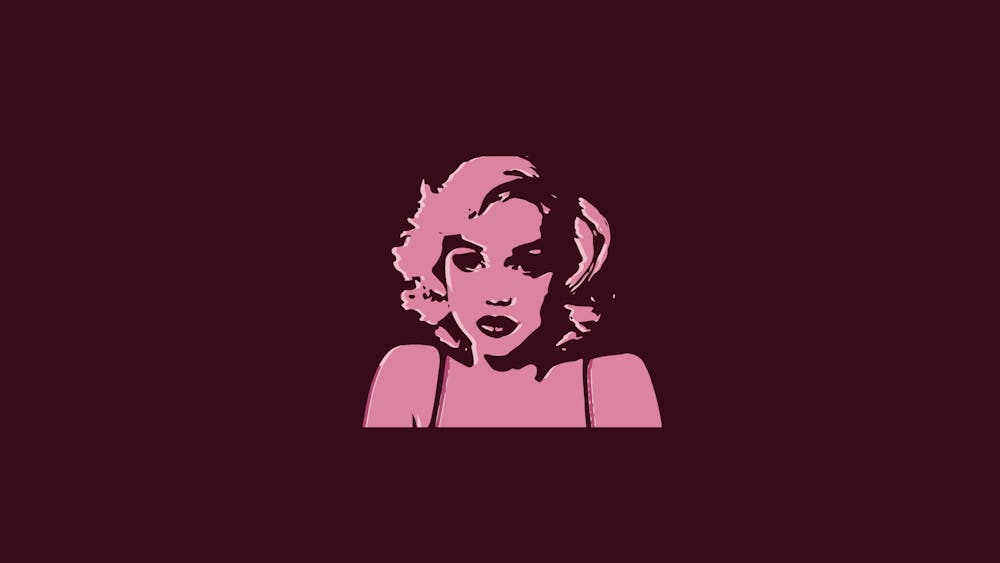Ten years after his bizarre, stylized neo–noir crime story, Killing Them Softly, Andrew Dominik returns with his newest, almost three–hour long feature film: Blonde. The film, which premiered at the 79th Venice International Film Festival and arrived on Netflix on Sept. 28, has faced heavy criticism over its extreme exploitation and overt simplification of Marilyn Monroe’s tragic life events. The runtime may seem to promise an in–depth, holistic rediscovery of Monroe’s life. Yet, Blonde is not a biopic, and despite the film’s blatant flaws, Dominik’s intention may lie somewhere other than an authentic representation of the blonde bombshell.
Instead of adapting from true events in Monroe’s life, Blonde is based on the 2000 best–selling novel of the same title by Joyce Carol Oates. Its introduction, written by Elaine Showalter, already asserts that “Blonde is not a biography of Monroe, or even a biographical novel that follows the historical facts of the subject’s life.” Starring Ana de Armas as Marilyn Monroe, Blonde the film also never intends to document Monroe’s life faithfully. Structurally, the film may seem to be a biopic that begins from a childhood incident, and ends with her tragic suicide, with a few subtle interludes that suggest the year and location of where events took place. However, while biopics usually offer holistic representations of people’s lives, continuous narrative, and characters with clear beginnings and endings, Blonde defies each aspect entirely. Characters appear and disappear without explanation. The prominent, almost excessive usage of shallow focus shots renders many scenes devoid of background environment and exaggerates a stage–like effect. Most importantly, a large portion of Monroe’s life is omitted from the film to highlight Hollywood’s sexual predation, her abusive marriage, and the objectifying gaze from the public.
This is also where most of the criticisms come in. Blonde is without doubt a drastic simplification and biased representation of Monroe’s life. With Dominik’s attention paying mostly to Monroe as a victim, one might still have no idea of what her life was like outside of the public sphere. In addition to its questionable selective presentation, the central storyline unabashedly summarizes and explains all of her life choices and suicide solely based on a century–old psychoanalytical argument of childhood trauma: an unstable mother and an absent father which predetermined her whole course of life. Blonde is also extremely exploitative in its repetitive, cruel showcase of misery, and its sheer magnitude and duration might baffle most audiences on the meaning that such sequences actually hold, while almost bordering on the extent of sadism and “tragedy porn.” This line of criticism is undoubtedly valid, but given that Blonde is actually a fictionalized take on Marilyn Monroe, maybe we should not disapprove of the film solely because of its historical inaccuracies and problematic approaches.
What replaces the straightforward, linear methodology for a biopic is a psychedelic ride that stresses on the audience’s subjective experience over objective understanding. Blonde is a luxuriant collage of all kinds of textures and forms: the film constantly alternates between different aspect ratios, color, and black and white. On the face of it, the film is distinguishing between Marilyn Monroe, the actress watched and desired by all, and Norma Jeane, the person seen and understood by none. But the working mechanism behind the collage is far more dazzling and even confusing, as it shows how difficult it is to neatly separate the two personalities. A masterful sequence, for example, cross–cuts between Monroe fatiguing on a plane and attending a film premiere, and through blurring the environments of a plane cabin and a theater, the line between Monroe’s private and public life and personality is blurred as well. What connects these sequences is the constant attention and gaze forced upon her. And in such a process, Hollywood was ceaselessly alienating her, slicing her into pieces until the human being behind all of the performances no longer existed.
Therefore, Blonde is trying to go beyond an objective understanding of the tragedy, but through its elaborate techniques, throws the audience into Monroe’s life so that they can experience the chaotic turbulence and extreme malice directed toward her. The audience is not meant to understand Monroe; instead, they are meant to feel her disorientation and despair. And Blonde even goes one step further. Throughout the film, Dominik proposes the idea that it is not only Hollywood, but its obsession with the audience that eventually kills her. There are countless sequences in the film that zoom into the screen from a theater, or zoom out of a scene to an auditorium. In addition to blurring the boundary between film and reality, such sequences also remind the audience that they’re watching a film, which gives Blonde a subtle meta quality. The audience watching Blonde, in turn, is incorporated into the narrative, taking the perspective of the audience in the film’s diegetic world; they eventually participate in gazing, objectifying, exploiting, and killing of Monroe. We are the culprit of the tragedy, and the tragedy does not end in history.







